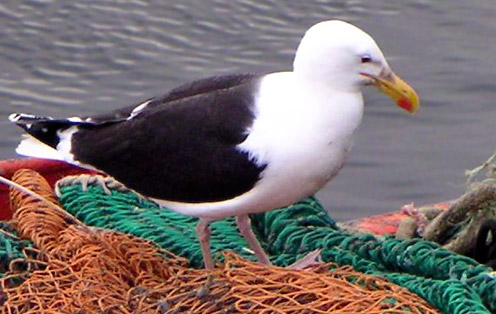| Kingdom: Animalia Phylum: Chordata Class: Aves (Birds) Order: Charadriiformes Family: Laridae |
 Great Black-backed Gull
Great Black-backed Gull (Larus marinus) is a probable vagrant in India. Size: 30 inch Identification: With its distinguished black and white plumage and huge size, the Great Black-backed Gull is easy to distinguish from other gull species. The Great Black-backed Gull is the largest gull in the world with a wing span of 163 cm and a weight between 1.6 and 2 kg. The female is similar to male, but considerably smaller. Food: It feeds both as a predator and a scavenger on fish and other birds. This gull is also a great devourer of eggs of other bird species. Description: All plumages: Legs and feet flesh-coloured. Adults: Back and upper surface of wings dark (almost black) slate; flight feathers tipped with white; rest of plumage white; bill yellow with red spot on lower mandible. Immatures: Mottled with dusky browns and grays, varying in density and pattern according to age. Breeding: Nests on the ground, usually on an island and in colonies. Single nests remote from others are sometimes placed in the crevices of large granite boulders protruding from lakes far in the interior of the province. I have no record of this species nesting in trees. The nests are composed of various quantities of coarse, decaying vegetable matter. Some nests are neatly and solidly constructed; others are crude affairs with little if any material being used. Eggs: 2-3, usually 3; light brown or buff, spotted evenly with dark brown or black. An egg without spots or blotches is sometimes laid, the ground colour being shades of light ashy blue or greenish olive. Such an egg may be one of three, the other two being normal; sometimes all three eggs are unspotted. Remarks: The Great Black-backed Gull is the largest gull in the world. It can be distinguished from the more common Herring Gull when both are seen in subadult plumages by its size and its paler head and neck. After about four years it wears its adult mantle of sombre, non-lustrous black, which contrasts sharply with its glistening white plumage. These colours explain why in many localities it is known as the "coffin-carrier" or "minister bird." |
 birding.in
birding.in
| Birds | Bird Diagram | Ornithology | Indian Sites | Bird Watching | Migration | North India | Birds of India | Haryana |
All rights reserved. Copyright © 2005-2013 Birds and birding in India. Disclaimer
website: Free Java Guide & Tutorials